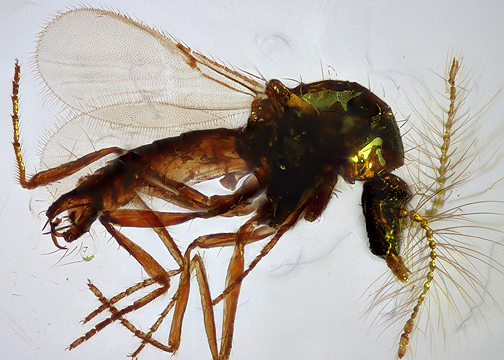Abstract
The first records of Ceratopogonidae, or biting midges, are from the earliest Cretaceous. The early Cretaceous representatives of the family are currently interpreted as haematophagous. †Minyohelea Borkent, 1995 is one of six extinct, bloodsucking ceratopogonid genera currently recorded (Pielowska-Ceranowska et al., 2021). So far, nine species of the genus Minyohelea have been described, with the most recently addition being M. nexuosa Pielowska-Ceranowska, 2021 from the Mdeyrij-Hammana amber locality in Lebanon. However, subsequent work has recovered an additional male specimen of M. nexuosa from a separate outcrop hosting Lebanese amber at 32 km South-West from Mdeyrij-Hammana outcrop at the Jezzine Fall (Fig. 1) in Wadi Jezzine village [Caza (= District) Jezzine, South Lebanon Governorate, Lebanon]. As this new specimen preserves additional morphological features not seen previously, this paper documents the additional details and provides an amended diagnosis for Minyohelea nexuosa Pielowska-Ceranowska, 2021. Previously missing morphological features are documented and illustrated here.
References
- Azar, D., Perrichot, V., Néraudeau, D. & Nel, A. (2003) New psychodids from the Cretaceous ambers of Lebanon and France, with a discussion of Eophlebotomus connectens Cockerell, 1920 (Diptera, Psychodidae). Annals of the Entomological Society of America, 96 (2), 117‒126.
- https://doi.org/10.1603/0013-8746(2003)096[0117:NPFTCA]2.0.CO;2
- Borkent, A. (2000) Biting midges (Ceratopogonidae: Diptera) from Lower Cretaceous Lebanese amber with a discussion of the diversity and patterns found in other ambers, 355e451. In: Grimaldi, D.A. (Ed.), Studies on fossils in amber, with particular reference to the Cretaceous of New Jersey. Backhuys Publishers, Leiden, p. 498.
- Borkent, A. (1995) Biting midges in the Cretaceous amber of North America (Diptera: Ceratopogonidae). Backhuys Publishers, Leiden, 237 pp.
- Dubertret, L. (1950) Carte géologique au 1:50 000; Feuille de Djezzîne. République Libanaise, Ministère des travaux publics, Beyrouth, 1 coloured map + notice 80 pp.
- Hennig, W. (1948) Die Larvenformen der Dipteren: eine Übersicht über die bisher bekannten Jungendstadien der zweiflügeligen Insekten, 1. Akademie-Verlag, Berlin, 184 pp.
- Latreille, P. A. (1825) Familles naturelles du règne animal, exposées succinctement et dans un ordre analytique, avec l’indication de leurs genres. J.-B. Baillière, Paris, 570 pp. https://doi.org/10.5962/bhl.title.16094
- Linnaeus, C. (1758) Systema naturae per regna tria naturae, secundum classes, ordines, genera, species, cum characteribus, differentiis, synonymis, locis. Tom. I. Editio duodecima, reformata. Laurentii Salvii, Holmiae [=Stockholm], 824 pp. https://doi.org/10.5962/bhl.title.542
- Maksoud, S., Granier, B., Azar, D., Gèze R., Paicheler, J.-C. & Moreno-Bedmar, J. A. (2014) Revision of “Falaise de Blanche” (Lower Cretaceous) in Lebanon, with the definition of a Jezzinian Regional Stage. Carnets de Géologie, 14 (18), 401–427.
- http://dx.doi.org/10.4267/2042/54359
- Maksoud, S., Azar, D., Granier, B. & Gèze, R. (2017) New data on the age of the Lower Cretaceous amber outcrops of Lebanon. Palaeoworld, 26, 331–338.
- https://doi.org/10.1016/j.palwor.2016.03.003
- Meigen, J. W. (1818) Systematische Beschreibung der bekannten europäischen zweiflügeligen Insekten. Aachen, xxxvi + 332 pp., errata (1 p.), 11 pls. https://doi.org/10.5962/bhl.title.12464
- Newman, E. (1834) Attempted division of British insects into natural orders. Entomological Magazine, 2, 379–431.
- Noè, G. (1907) Due nuove specie di ditteri appartenenti ad un genere nuovo. Archivio Zoologico Italiano: Pubblicato sotto gli auspicii della Unione Zoologica, 3, 101–163, 2 pls.
- Pielowska-Ceranowska, A., Azar, D. & Szwedo, J. (2021) New fossil biting midge from the Lower Cretaceous amber of Lebanon (Diptera: Ceratopogonidae). Cretaceous Research, 129, 105004, 1–9. https://doi.org/10.1016/j.cretres.2021.105004
- Szadziewski, R. (1996) Biting midges from Lower Cretaceous amber of Lebanon and Upper Cretaceous Siberian amber of Taimyr (Diptera, Ceratopogonidae). Studia Dipterologica, 3, 23–86.


